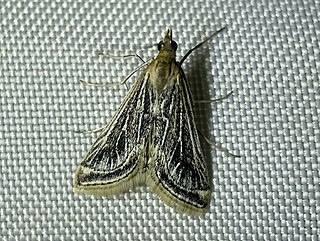
Parapediasia is a genus of moths of the family Crambidae.

Parapediasia teterrellus, the bluegrass webworm moth, bluegrass webworm, bluegrass sod webworm moth or bluegrass sod webworm, is a moth of the family Crambidae.

Charles Henry Fernald was an American entomologist, geologist, and zoologist, who is credited as the first college professor of economic entomology. Fernald grew up at Fernald Point in Mount Desert, Maine, and went on to prepare for college at Maine Wesleyan Seminary before joining the navy in 1862. After receiving a master's degree from Bowdoin College he went on to serve as principal of several academies in Maine. Throughout his career he would document and describe several species of microlepidoptera and in 1886 became the first full-time professor and chair of the natural sciences at what is now the University of Massachusetts Amherst. Fernald Hall and the Fernald Entomological Society at the same institution, are named for him and his son, Henry Torsey Fernald, who would later hold the same position as his father. His wife, Maria Elizabeth Fernald, was a noted entomologist in her own right.
Elophila nebulosalis, the nebulous munroessa moth, is a moth in the family Crambidae. It was described by Charles H. Fernald in 1887. It is found in North America, where it has been recorded from South Carolina to Florida.
Epina alleni is a moth in the family Crambidae. It was described by Charles H. Fernald in 1888. It is found in North America, where it has been recorded from Indiana, Maine, Massachusetts, Pennsylvania and South Carolina.
Crambus multilinellus, the multinellus grass-veneer, is a moth in the family Crambidae. It was described by Charles H. Fernald in 1887. It is found in North America, where it has been recorded from Florida, Georgia, Illinois, Maryland, Minnesota, Mississippi, North Carolina, Ontario and South Carolina.
Fissicrambus albilineellus is a moth in the family Crambidae. It was described by Charles H. Fernald in 1893. It is found in North America, where it has been recorded from southern California.
Loxocrambus coloradellus is a moth in the family Crambidae. It was described by Charles H. Fernald in 1893. It is found in North America, where it has been recorded from California and Colorado.
Neodactria zeellus is a moth in the family Crambidae. It was described by Charles H. Fernald in 1885. It is found in North America, where it has been recorded from Alberta, Florida, Indiana, Maine, Maryland, Massachusetts, Mississippi, Ohio, Oklahoma, Pennsylvania and Tennessee.
Thaumatopsis bolterellus is a moth in the family Crambidae. It was described by Charles H. Fernald in 1887. It is found in North America, where it has been recorded from New Mexico and Texas.
Thaumatopsis magnificus is a moth in the family Crambidae. It was described by Charles H. Fernald in 1891. It is found in North America, where it has been recorded from New Mexico, Arizona and Colorado.
Thopeutis forbesellus is a moth in the family Crambidae. It was described by Charles H. Fernald in 1896. It is found in North America, where it has been recorded from California, Illinois, Indiana, Louisiana, Maine, Maryland, Massachusetts, Minnesota, New Brunswick, Ohio, Ontario, Quebec and South Carolina.
Daulia magdalena, the glittering Magdalena moth, is a moth in the family Crambidae. It was described by Charles H. Fernald in 1892. It is found in North America, where it has been recorded from Alabama and Florida.

Pyrausta inornatalis, the inornate pyrausta moth, is a moth in the family Crambidae. It was described by Charles H. Fernald in 1885. It is found in United States, where it has been recorded from Arizona, California, Florida, Arkansas, Kansas, Louisiana, Missouri, Oklahoma, Tennessee and Texas. It is also found in Mexico.

Pyrausta linealis is a moth in the family Crambidae. It was described by Charles H. Fernald in 1894. It is found in North America, where it has been recorded from eastern Washington to California and Nevada.
Donacaula maximellus is a moth in the family Crambidae. It was described by Charles H. Fernald in 1891. It is found in North America, where it has been recorded from Florida, Georgia, Louisiana, Mississippi, Nebraska, North Carolina and South Carolina.
Leptosteges flavicostella is a moth in the family Crambidae. It was described by Charles H. Fernald in 1887. It is found in North America, where it has been recorded from Florida, South Carolina and Georgia.
Pogonogenys proximalis is a moth in the family Crambidae. It was described by Charles H. Fernald in 1894. It is found in North America, where it has been recorded from California and Nevada.
Choristostigma plumbosignalis is a moth in the family Crambidae. It was described by Charles H. Fernald in 1888. It is found in North America, where it has been recorded from British Columbia and Alberta to Arizona and New Mexico, east to South Dakota. The habitat consists of grassland coulees, the aspen parkland, as well as wooded areas in boreal forests and mountainous areas.

Diasemiodes nigralis is a moth in the family Crambidae. It was described by Charles H. Fernald in 1892. It is found in North America, where it has been recorded from Florida to Texas, with strays north to at least Michigan and Maryland.





